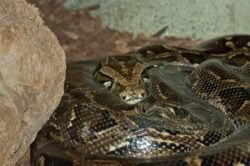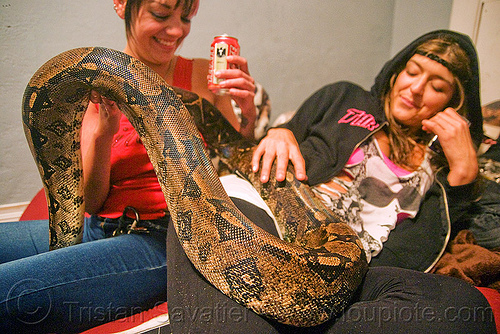
Temperature: The average daytime temperature of the enclosure for these snakes should be in the range of 83-87☏, while the nighttime temperature should be 73-78☏. Moving the prey by use of tongs may help it to appear alive to the snake. (This allows the prey item’s temperature to approximate body temperature while keeping it dry and maintaining its natural scent.) Feeding the snake in an enclosure other than its cage helps keep the snake from thinking it is going to be fed each time someone comes to handle it.

Warming frozen prey involves placing it in a plastic bag before soaking the bag in hot water. Never leave live prey and a snake in an unsupervised enclosure. Most importantly, live rodents, especially rats, can bite and scratch the snake, causing severe damage and even death, regardless of the snake’s size. There are theories that freezing prey can kill parasites or bacteria that may be passed from the prey to the snake. It is more convenient and less expensive to buy this food in bulk and store it in a freezer. Using pre-killed, frozen prey has many advantages. Frozen pre-killed animals can be bought in bulk and stored easily. By far the best type of prey is to use are whole animals that have been pre-killed. Larger snakes are generally fed adult rodents, rabbits, or occasionally chickens. The smallest snakes eat “pinkies”, “fuzzies”, or “hoppers”, which are different developmental stages of mice or rats. Some wood shavings such as cedar contain aromatic oils that can irritate the snake’s respiratory tract.ĭiet and feeding: Pythons and boas are most commonly fed rodents, with the size and number of the prey items depending on the size of the snake itself. As far as substrates are concerned, this author prefers newspaper, as it is very safe (non-toxic) and inexpensive. Some reptile enthusiasts provide branches in their enclosures for arboreal snakes this is not necessary for terrestrial species.

A hiding place can greatly reduce stress for the snake, ultimately leading to a longer, happier life. Remember that this hiding place should be constructed so that the owner can easily remove the snake from it. This author recommends that each snake should have a hide-box, or place into which it can retreat from sight. Glass aquariums are the most commonly used enclosures for pet snakes.
Large constrictor snakes pet free#
The enclosure should be easy to clean, have adequate room for the snake to move around, provide proper ventilation, and be free of sharp points or edges. Housing: There are a variety of enclosures and types of “set-up” that are used for keeping snakes, but they all must have certain characteristics. Any potential pet owner should thoroughly research the animal before obtaining it. Note: This work confers generalized principles in keeping more commonly owned tropical snake species, and should not be used as a definitive guide for all species. Potential snake owners should realize that all snakes are masters of escape and should be kept in fully secure enclosures for their sake and others’. Many species can live to be 20-30 years old. Additionally, the owner should understand that many adult snakes of these breeds need considerable care, including large enclosures with an associated greater amount of clean-up time.

While pythons and boas are not venomous, certain varieties can grow beyond 12-15 feet and weigh up to 300 lbs. Of course, there are some snake species whose venomous nature, large size, or aggressive temperament makes them dangerous.

Snakes are interesting pets that can provide a source of enjoyment for their owners, and like all animals, have certain requirements for a happy, healthy life.


 0 kommentar(er)
0 kommentar(er)
